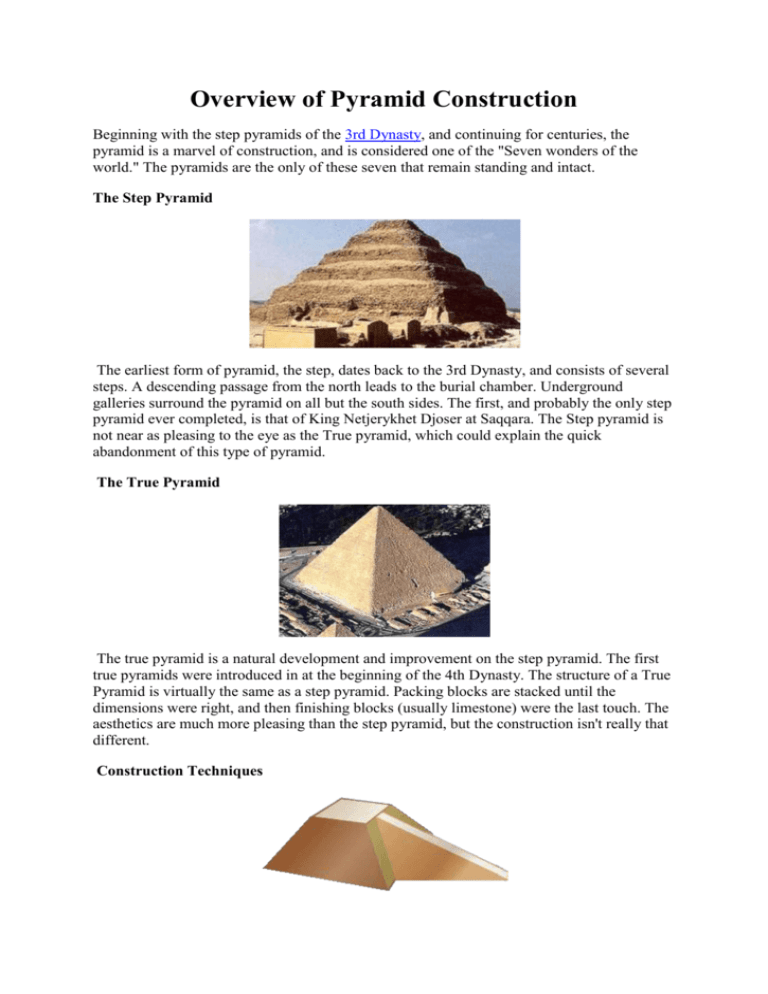The Step Pyramid
advertisement

Overview of Pyramid Construction Beginning with the step pyramids of the 3rd Dynasty, and continuing for centuries, the pyramid is a marvel of construction, and is considered one of the "Seven wonders of the world." The pyramids are the only of these seven that remain standing and intact. The Step Pyramid The earliest form of pyramid, the step, dates back to the 3rd Dynasty, and consists of several steps. A descending passage from the north leads to the burial chamber. Underground galleries surround the pyramid on all but the south sides. The first, and probably the only step pyramid ever completed, is that of King Netjerykhet Djoser at Saqqara. The Step pyramid is not near as pleasing to the eye as the True pyramid, which could explain the quick abandonment of this type of pyramid. The True Pyramid The true pyramid is a natural development and improvement on the step pyramid. The first true pyramids were introduced in at the beginning of the 4th Dynasty. The structure of a True Pyramid is virtually the same as a step pyramid. Packing blocks are stacked until the dimensions were right, and then finishing blocks (usually limestone) were the last touch. The aesthetics are much more pleasing than the step pyramid, but the construction isn't really that different. Construction Techniques A major problem facing the builders of the Ancient Egyptian Pyramids, was that of getting the Large stone blocks to the height they required. the method shown at left, is the only one proven to have been used. The ramps were built on inclined planes of mud brick and rubble. They then dragged the blocks on sledges to the needed height. As the pyramid grew taller, the ramp had to be extended in length, and its base was widened, else it would collapse. It is likely that for the construction of each pyramid, several ramps were probably used. The arrangement of the ramps used for building is in much dispute. Assuming that the step pyramid was built before the outer structure, and then the packing blocks were laid on top, the ramps could have run from one step to another rather than approaching the pyramid face at right angles. Some of the pyramids indicate an accurate understanding of Pi, but the mathematical knowledge of the Egyptians did not include the ability to arrive at this by calculation. It is possible that this could have been arrived at "accidentally" through a means such as counting the revolutions of a drum. The internal construction of most true pyramids consists of a series of support walls surrounding a central core. The core of the true pyramid is essentially a step pyramid. The internal arrangement added stability to the structure. Packing blocks filled the "steps" formed by the faces of the outermost walls and casting blocks (often Limestone) completed the structure of the true pyramid. Architects and builders used a different form of construction in the pyramids of the 12th and 13th Dynasties. Mainly because of economy, for it was suitable for relatively modest structures in inferior materials. Solid walls of stone ran from the center, and shorter cross walls formed a series of chambers filled with stone blocks, ruble or mud bricks. An outer casing was usually added, and although quite effective in the short term, it did not even come close to the earlier construction methods. Pyramids which were built with this structural design are quite dilapidated and worn.






